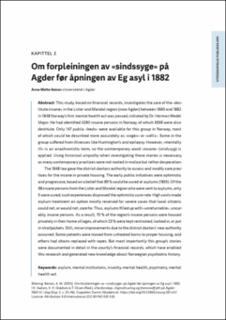| dc.contributor.author | Seines, Anne Mette | |
| dc.date.accessioned | 2023-11-28T10:01:53Z | |
| dc.date.available | 2023-11-28T10:01:53Z | |
| dc.date.created | 2023-11-27T11:04:53Z | |
| dc.date.issued | 2023 | |
| dc.identifier.citation | Seines, A. M. (2023). Om forpleiningen av «sindssyge» på Agder før åpningen av Eg asyl i 1882. I K. Vadum, K. H. Grødum & T. Olsen (Red.), Utenforskap, stigmatisering og fremmedfrykt på Agder: 1860 til i dag (Kap. 2, s. 25–46). Cappelen Damm Akademisk | en_US |
| dc.identifier.isbn | 978-82-02-82581-2 | |
| dc.identifier.uri | https://hdl.handle.net/11250/3104969 | |
| dc.description.abstract | This study, based on financial records, investigates the care of the «destitute insane» in the Lister and Mandal region (now Agder) between 1860 and 1882. In 1848 Norway’s first mental health act was passed, initiated by Dr. Herman Wedel Major. He had identified 4290 insane persons in Norway, of which 3939 were also destitute. Only 147 public «beds» were available for this group in Norway, most of which could be described more accurately as «cages» or «cells». Some in the group suffered from illnesses like Huntington’s and epilepsy. However, «mentally ill» is an anachronistic term, so the contemporary word «insane» (sindssyg) is applied. Using historical empathy when investigating these stories is necessary, as many contemporary practices were not rooted in malice but rather desperation. The 1848 law gave the district doctors authority to assess and modify care practices for the insane in private housing. The early public initiatives were optimistic and progressive, based on a belief that 80 % could be cured at asylums (1855). Of the 98 insane persons from the Lister and Mandal region who were sent to asylums, only 5 were cured; such experiences disproved the optimistic cure-rate. High costs made asylum treatment an option mostly reserved for severe cases that local citizens could not, or would not, care for. Thus, asylums filled up with «unreturnable», uncurably, insane persons. As a result, 70 % of the region’s insane persons were housed privately in their home villages, of which 23 % were kept restrained, locked in, or put in straitjackets. Still, minor improvements due to the district doctors’ new authority occurred. Some patients were moved from unheated barns to proper housing, and others had chains replaced with ropes. But most importantly this group’s stories were documented in detail in the county’s financial records, which have enabled this research and generated new knowledge about Norwegian psychiatric history. | en_US |
| dc.language.iso | nob | en_US |
| dc.publisher | Cappelen Damm Akademisk | en_US |
| dc.relation.ispartof | Utenforskap, stigmatisering og fremmedfrykt på Agder: 1860 til i dag | |
| dc.rights | Attribution-NonCommercial-NoDerivatives 4.0 Internasjonal | * |
| dc.rights.uri | http://creativecommons.org/licenses/by-nc-nd/4.0/deed.no | * |
| dc.title | Om forpleiningen av «sindssyge» på Agder før åpningen av Eg-asyl i 1882 | en_US |
| dc.type | Book chapter | en_US |
| dc.description.version | publishedVersion | en_US |
| dc.rights.holder | © 2023 The Author(s) | en_US |
| dc.subject.nsi | VDP::Humaniora: 000::Historie: 070 | en_US |
| dc.source.pagenumber | 25–46 | en_US |
| dc.identifier.doi | https://doi.org/10.23865/noasp.201.ch2 | |
| dc.identifier.cristin | 2202767 | |
| cristin.qualitycode | 1 | |

